About UCMP : News and events : UCMP newsletter
The development of modern paleontology at Berkeley
 |
 |
 |
 |
This is the fourth in a series of articles on the history of UCMP, adapted from a more detailed and referenced paper by Jere H. Lipps: 2004. Success story — the history and development of the Museum of Paleontology at the University of California, Berkeley. Proceedings of the California Academy of Sciences 55 (Suppl. I):209243. 22 figs.
|
 |
 |
 |
 |
 |
 |
 |
 |
 |
 |
 |
 |
As Annie Alexander renewed her support and endowed UCMP, Berkeley emerged as a leader in paleontology. Camp, Welles (below right), Stirton, Clark, and Cheney built a strong reputation for the museum and teaching program in the major disciplines of the science.
 |
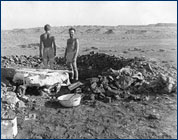
Sam Welles (right) and Ed Cott in the Arizona desert, 1942, after excavating the bones of Dilophosaurus. Welles felt that the chief duty of a paleontologist was the collection and preservation of fossils before natural processes or unscrupulous collectors destroyed them.

At the Golden Gate International Exposition on Treasure Island in 1939-1940, the sculptures of William Gordon Huff were displayed in the UCMP exhibit. This image shows Smilodon californicus, the California State Fossil established in 1974 with the help of Don Savage.
|
In 1939 and 1940, UCMP held its first major outreach effort at the Golden Gate International Exposition on Treasure Island. The exposition celebrated the openings of the San Francisco-Oakland Bay Bridge (1936) and the Golden Gate Bridge (1937), the economy of the Bay Area, Pacific unity, and the Bay Area as a gateway to the Pacific Rim. UCMP had an exhibit of Bay Area fossils, augmented by sculptures by William Gordon Huff (right). The Exposition was very popular — over 100,000 people visited on opening day alone.
Paleontology declined as World War II developed. The west coast of the US was a designated combat zone, causing concern for the collections: "… attention has already been given to the preservation of types from destruction. Some thought has even been given to the preservation of paleontologists, but they, of course, can be replaced." (Vanderhoof 1942). Charles Camp served in the Coast Guard, Sam Welles was in Electrical Engineering in the Engineering Science War Training Program, and Vanderhoof joined the Manhattan Project. However, after the war, paleontology regained its vitality, and by 1955 the Department had six paleontologists (below left) and UCMP had its own staff.
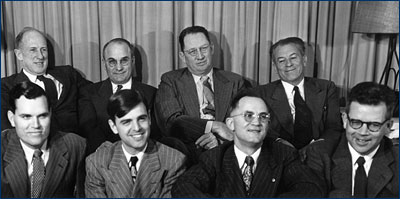
Faculty of the Paleontology Department, UC Berkeley, about 1955. Clockwise from top left: Ralph W. Chaney, Ruben A. Stirton, Robert M. Kleinpell, Charles L. Camp, J. Wyatt Durham, Sam Welles, Ralph L. Langenheim, and Donald E. Savage.
.
|
 |
In vertebrate paleontology, Charles Camp established himself as an outstanding reptilian paleontologist by virtue of his collecting and publishing activities. He trained a continuing line of vertebrate paleontologists and wrote outstanding descriptive and interpretive monographs and papers on various fossil reptiles. He and Welles collected Triassic ichthyosaurs (40 Shonisaurus populari) from what later became Nevada's Berlin-Ichthyosaur State Park (below right). S. populari, until recently the largest ichthyosaur known, is now the Nevada State Fossil. Sam Welles received his Ph.D. on plesiosaurs at Berkeley (1940) and dedicated himself to the collection and description of vertebrate fossils. He worked closely with Camp in the field, though he also made major contributions of his own. He described the plesiosaur Hydrotherosaurus alexandrae and dinosaur Dilophosaurus, among many others. Ruben Stirton, UCMP curator since 1930, was appointed in 1949 as Professor, Chair of the Department of Paleontology, and Director of UCMP. His research in mammalian paleontology attracted many undergraduate and graduate students. He wrote a textbook of general paleontology (Stirton 1959), published extensively on mammals, and organized a major field expedition to uncover the history of marsupials in Australia (below left) and enhance the UCMP collections. Donald Savage continued on as a faculty member after finishing his Ph.D. in the Department of Paleontology under Stirton in 1949. His work featured the description and stratigraphy of vertebrate faunas throughout the west. Savage collaborated with geologists to document radiometric dates of the vertebrate ages across western North America. He too had outstanding students and was well known for his displays of fossils exhibited by UCMP. Savage also worked to have the saber-toothed cat, Smilodon californicus from Rancho La Brea, declared the California State Fossil in January 1974.
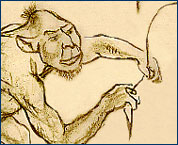 |
 |
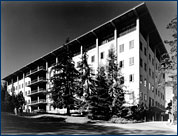 |
 |
Left: A cartoon sent to Ruben Stirton by the sculptor William Huff to celebrate "Stirt's" Australian expedition. Right: The west facade of the Earth Sciences Building, now McCone Hall, as it appeared in 1975.
|
Paleobotanist Ralph Chaney worked on fossil floras and taught paleobotany from 1931 to 1957, producing both students and publications. He documented the history of redwoods in North America and returned from China with seeds and seedlings of the imperfectly known dawn redwood, thought to be extinct. Two of Chaney's specimens still grow outside McCone Hall (left).
 |
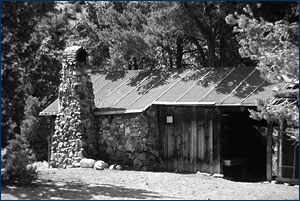
The cabin of Charles Camp and Sam Welles at their ichthyosaur dig near the ghost town of Berlin, Nevada. Built from scavenged lumber, Camp and Welles, with their field crews, used this cabin from 1955 to the 1960s for living, lab work, storage, and packing fossils. Both Camp and Welles worked to get a Nevada State Park, known as Berlin-Ichthyosaur State Park, established for the ghost town and fossil location.
|
Microfossils were studied by Robert M. Kleinpell, who established a Miocene biostratigraphy of California and was appointed to the Berkeley faculty in 1946. His work on foraminiferal biostratigraphy was essential for exploration in the thriving oil industry. A long line of students studied with him in micropaleontology and they published influential and important works on fossil foraminifera and the biostratigraphy of California. They also made a huge collection of foraminifera that form an outstanding UCMP resource. Kleinpell was regarded as the foremost Californian micropaleontologist by the oil industry and academics alike.
In invertebrate paleontology, J. Wyatt Durham was named to the faculty and museum in 1947. He too had many students, and he published widely on many groups and their history, dealing with biostratigraphy, paleoecology and evolution. He held strong opinions on continental drift, and later, plate tectonics. His collecting took him far away to collect both modern and fossil animals. He was especially attracted to the Galapagos Islands and the amber deposits of Chiapas, Mexico. Later, Ralph Langenheim, interested in carbonate environments and faunas, taught in the department from 1952-57. He worked on ancient corals and brachiopods throughout his career starting first at Berkeley.
During the two decades following WWII, UCMP became internationally known as a center for paleontology and it attracted many students and visitors alike.
References
- Stirton, R.A. 1959. Time, Life, and Man; The Fossil Record. John Wiley, New York.
- Vanderhoof, V.L. 1942. News from California: University of California, Berkeley. Society of Vertebrate Paleontology News Bulletin (9):12.





